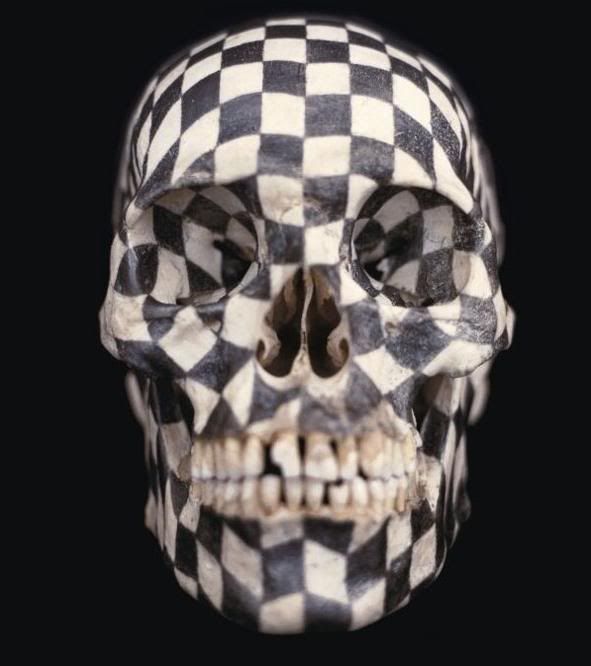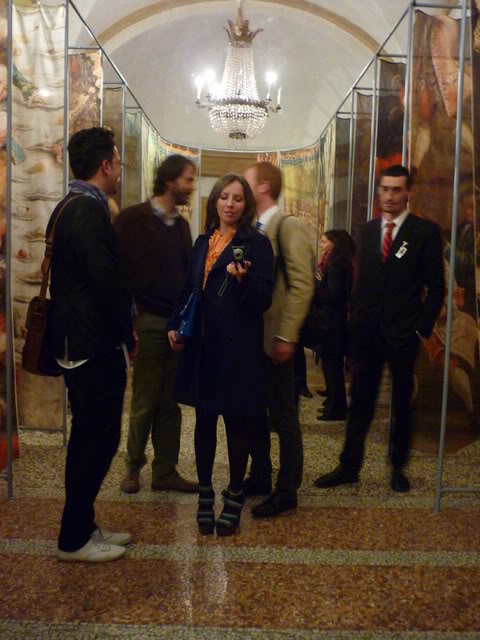
Black Kites, 1997. © Gabriel Orozco. Courtesy Tate Modern.
When TJ and I arrived in Paris last October for our 20-hour Nuit Blanche art bender, we readied ourselves for the eve ahead with a can of coke and a cigarette. Sitting in the square outside the Pompidou, TJ noticed a camera on a tripod a few yards away. Obligingly, I went over to investigate. There were signs taped down in front of the camera instructing readers of said sign to pose for a self portrait. A camera remote sat nearby for just that purpose. We excitedly snapped a few too many silly poses before skipping off into the white night, but frustratingly, I never found out who the artist was or what the project was, or even whether the thing was an arts project at all.
On our way to Notre Dame, I remember we pressed our faces up against the glass walls of the Pompidou to reveal the secret of the shadows we could barely make out while walking past. In a large room, we saw a fan whizzing around with rolls of white toilet paper elegantly swooshing down like a rhythmic gymnast’s ribbon. We saw a Citroën DS with the middle cut out, then smushed back together like an oreo cookie without any filling. We both recognised the car but, between the two of us, we couldn’t manage the artist’s name. When the press release for the Gabriel Orozco show at the Tate Modern went round, the images clicked and I realised whose work we’d seen through the Pompidou’s windows.
I want to like this show. But I don’t. It depresses me. It’s like going on a first date with someone whose photos you’ve only seen on Facebook. Online, he’s not half bad; a bit pretty, witty messages. But when you’re across the table at The Ambassador, his prettiness is nice enough and his chat’s alright but by the time the starters have been cleared away the conversation’s flagging and relatively pretty just isn’t good enough. It’s not that this show is offensive or tedious or really, truly horrible, but that it’s empty. Like my terrible blind date metaphor, it’s empty but trying to hint at meaning through tired clichés.
Relativism’s such a pain in the ass. It’s done the art world little good. The nightmare that is post modernity resulted in an approach that says it doesn’t matter what’s ‘good’ or ‘bad’ because everyone’s opinion is equally valid. I’m open to being wrong, but this strikes me as a load of old hair-loss replacement bollocks. Sure, we don’t all have to agree on what’s ‘good’ – there would hardly be a need for art if that were the case – but criticism by its very definition must assume that some works of art are more worthy than others. Contrary to relativistic dogma, it’s a critic’s job to make judgements, but the increasing power of institutions and PRs means that most ‘criticism’ tends to be expressed as art history or back-slapping positivity. Not that either of those are intrinsically bad – I love a good bit of back-slapping positivity and I love being excited about things – but reading the newspapers, magazines, and even blogs, you’d think that every single art show was an absolute masterpiece.
I’m getting a little side tracked.
One of Orozco’s more visually striking pieces, Black Kites, is a human skull with a drawn on black and white geometric pattern. The skull is wonderful to look at, briefly, but it has no power as a work of art. It solicits no emotional response, no feeling; it’s like looking at a trinket in a curiosity shop. So you can understand why I’m not comfortable when critics and curators say things like: ‘the skull, an organic reality, engages with and parries the attempt of the artist to impose a system, a sense of regularity and order.’ Why do people still write like this? What does ‘organic reality’ even mean? Here the truism holds that clouded language denotes clouded thought: such a statement entirely neglects the fact that nature has its own set of systems and rules, its own order. A black and white pattern isn’t ‘reason’ to the skull’s ‘uncertainty’.
I look at Black Kites and I see a skull with a pretty pattern on it. That’s it. Nothing more. It doesn’t make me think about life, art, death, desire; but what Dave Hickey calls 'scholastic post-minimalism - "fast art" designed for the institutional, white-box quick-take.'
With so many of Orozco’s works, the concept or process has been privileged – chopping the middle out of a Citroën DS and putting it back together, tracking down matching yellow scooters to photograph them as a pair, filling a chess board with nothing but rooks, displaying an empty shoebox, taking photographs of the steam of breath on a piano, extracting amusing phrases from obituaries to write out on banners – to the detriment of the visual effect of the physical work.
There’s nothing here to look at. In effect this exhibition is a promenade piece: it’s contemporary art that’s the product of a society with no attention span. You can amble through the entire show without stopping to pause for a single sustained look. Hickey again perfectly encapsulates my desire for more than just food for thought: ‘I want an image that I can keep looking at, some kind of sustained eloquence, an image that perpetually exceeds my ability to describe it.’
This probably isn’t the place to get into a discussion about the importance of beauty, and I mean beauty as something that provokes a physical response, not simply as a box-ticking set of aesthetic guidelines, but art needs more than surface tricks to mean something, to move someone. It’s no good if you look at the work, aren’t moved, then read the explanatory text and feel more intrigued by the conceptual underpinnings of the work rather than the finished piece itself. This art has no power. Orozco’s pieces aren’t persuasive. They don’t demand my attention or evoke a physical response. Witty though much of his work may at first appear, to me it just isn’t interesting.




No comments:
Post a Comment